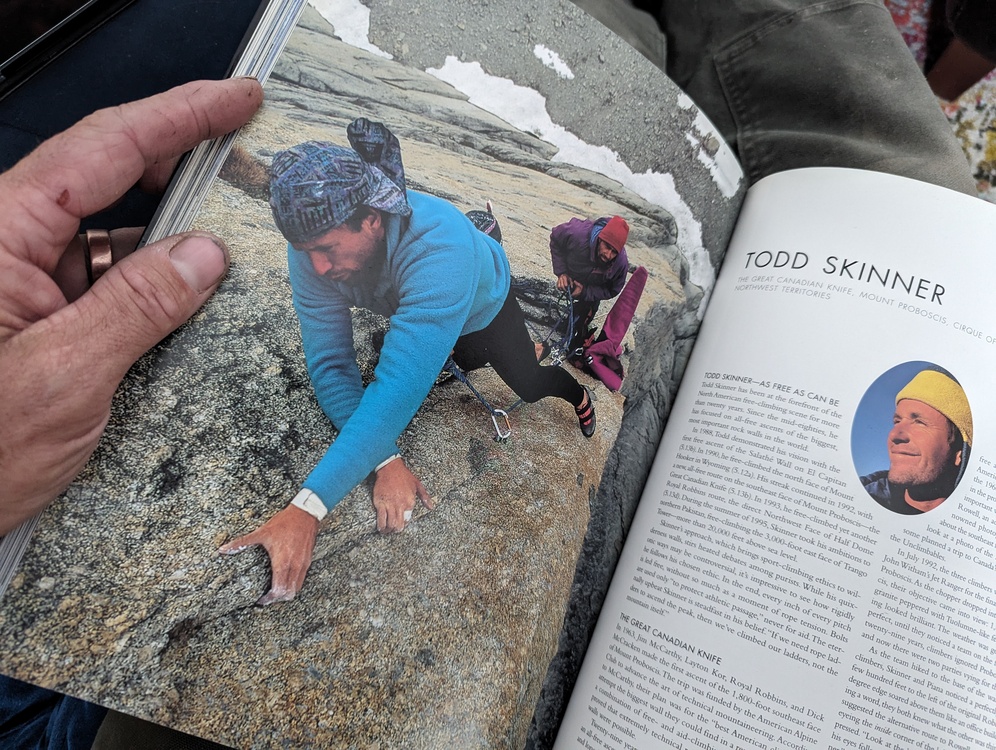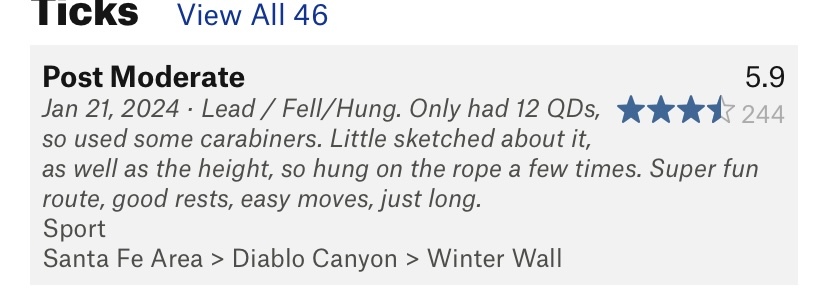Clipping bolts with a single carabiner vs a quickdraw
|
|
I have 12 quickdraws, which is not enough. Today I climbed a 17 bolt route, and used a locking carabiners instead of quickdraws on a few bolts. Is this safe? What about non-locking carabiners? |
|
|
Elijah L wrote: What do you think about it being safe? |
|
|
Did you know there were 17 bolts before you started? Serious question. If you did, why did you think that was ok? This is not the beginner forum so I’m assuming you thought this through pre-launch. |
|
|
It’s not ideal, and you probably should have checked the number of bolts before you even got out, and in general if you don’t have the gear to climb something, you just shouldn’t get on it. We’re gonna chalk that up to inexperience, and note you should find mentors. Moving on. In general, QuickDraws are doing a few things: first they’re just, easier to use. I’m sure you noticed that. Got a little handle in the form of the dog bone, gates tend to be a bit friendlier, etc. They also reduce drag by giving the rope space to move, make it more difficult for the carabiner to cross load/come unclipped in a fall, and helps prevent the carabiners from breaking on edges. So was it likely to cause an injury/fatality? Just depends on the route and how you used it. If you placed them on easy parts, mixed in with other draws, it’s not a great idea and I would recommend against it, but probably didn’t greatly increase the chance of injury/fatality. What’s much worse is you took risks without understanding the risk. We all take risks when climbing, and we all do some janky shit sometimes. But before you do janky shit, you have to be able to understand the risk you’re adding and how to mitigate it. That’s how you do janky shit in a still generally safe way. This time you got lucky, it probably wasn’t a major risk. Next time, you or your partner may not get so lucky. |
|
|
Daniel said it all. 5 draws at a great price to get you up to 17: https://www.mountainproject.com/forum/topic/125604833/fs-ange-s-draws-grivel-clepsydra-atcs |
|
|
I've done it more than once, even dismantling draws to do it on more than one bolt (serious screwup). It's how things were done before quickdraws were invented. It's safe enough, especially with a locking biner. If the biner would be loaded across an edge, then so would a quickdraw biner. Your main problem will be possibly increased rope drag. |
|
|
John Pitcairn wrote: That’s not true lockers have bulkier gates that can get caught in the hanger, and they have zero extension so that carabiners gonna be moving a lot. Ultimately you’re sport climbing so why make it dangerous? |
|
|
Disregarding the method used to protect when you run out of your conventional means (this could be debated almost endlessly), it's important to point out a few things. First, one would assume by the route's description, that it's documented somewhere. I say this because of the sheer amount of fixed protection in the form of bolts (again, this is an assumption because it's not stated outright in the OP). If it's documented, and the OP failed to look the route up and prepare appropriately, that means this circumstance was 100% avoidable. I think this is way more important than the method used to get out of the circumstance unscathed, simply because it was 100% avoidable. |
|
|
Yes, one should always do the research and have a good idea of the pro required for a given route. Having said that (kinda agree with Jake above), sometimes you just have to do what you have to do… I’m pretty sure a lot of us have resorted, at one time or another, to using a prusik or hollow block for a sling or to extend… used our chalk bag cord for a rappel back up… and, yes, a single biner on a bolt. (BITD, I remember using two biners on some bolt hangars so the rope would flow out correctly). Are you gunna die? Probably not IMHO. |
|
|
Ignorance is bliss. Many--many years ago in the pre-clean protection era, long before quick-draws appeared, and even before the idea of using slings as 'extensions' was common, it was quite normal practice to clip directly into pitons or the rare bolt with single, non-locking carabiners. When we did want some extension from the piece, we would often link 2 or more biners into a chain!!!! In retrospect,it is amazing that we survived!!! Even today, in certain circumstances folks may use a single locking biner in the first bolt to reduce the length of a potential fall before the second bolt is clipped. |
|
|
Besides the points above, there are some physical reasons to generally avoid this tactic. 1, your "gear side" or "bolt side" carabiner will have nicks, grooves, and sharp edges on it from hanging on bolts. When used for a rope, now those sharp edges can tear the sheath. I think it was DMM that did some testing and made a video on this in the past few years. 2, your follower is going to have a hard time unclipping the solitary biner from the bolt and rope. 3, the loose biner/dogbone/captive biner assembly of quickdraws allows the draw to sway and move without cross-loading any part in the structure. The solitary biner is likely to move around and get stuck cross-loaded, where it will break under a fall. Finally, and this is not a point worth numbering, but something to consider. I see that you're young. I know this means you are not loaded with money. But you have chosen a sport where your life is in the gear you choose to use. Your life is worth a few more bucks in gear. Your life is worth a new $200-$300 rope every 1-2 years. Similarly with guidebooks, it's worth it to buy guidebooks. You didn't mention this in your post, but I see it a lot on the forums and Facebook pages. Many people just want to borrow a guidebook, but I have guidebooks I have used only once (some never!) and they are all treasured items in my collection. 10-20 years from now, you'll look at that out-of-print guidebook and be glad you had it. |
|
|
|
|
|
Am I the only one thinking this isn't a big deal? Based on how most sport climbs are less than 120 feet, 17 bolts is generous bolting. If you employed the single carabiner high on the route then you could have a carabiner or two fail before catastrophe. |
|
|
The most dangerous part was asking the damn question on MP |
|
|
Also what is the cross-load rating for a carabiner, 8kn? I have taken some huge wingers on gear rated equal to or lower than that and been fine. It seems unlikely to generate an 8kn fall force high on a route. Would you bend or deform the carabiner? Maybe, but the idea of it exploding seems far fetched |
|
|
Tristan P wrote: It is not uncommon for gates to blow out on cross-loaded carabiners. There is also a higher chance with a single carabiner that the rope ends up pinched between the carabiner and the the rock when on vertical to less than terrain, and this has actually resulted (very rarely) in rope failure. |
|
|
It’s so easy to click the OP profile. 17 bolts 135 feet, use intermediate anchor to get down. Year 2000 route so probably not in a guidebook. OP, with a locking biner, I don’t think it was too big of a deal. It used to be common practice to clip a single nonlocking biner to the rare 1/4 inch bolt or piton on a route. These were beefy ovals, with much stiffer gates, less likely to unclip than many modern biners. But with a locking biner? The danger is that there could be less rotational freedom around the bolt which would cause some rope drag , or at the very worst case scenario, some kind of crossloading situation in a fall. With bolts every 8 feet, I wouldn’t be too worried about it. If you are like a lot of newer climbers, you probably bought a 12 pack of identical dogbone style quickdraws. When you add to that, add some variety to your rack with draws that are more flexible and longer (e.g. an alpine draw that can be extended for rope management scenarios). A draw with a Edelrid slider lock can be an added safety feature at critical clips. Less bulky than a typical locker. |
|
|
Not ideal, not likely to kill you. |
|
|
Charlie S wrote: This is a disproved myth FYI. The small nicks have no impact on the sheath of a rope. The whole purpose of the sheath is to withstand this type of wear. |
|
|
grug g wrote: Source? Very interested. |
|
|
You’ll survive. It is not ideal because there is a chance of cross loading or levering the carabiner on the bolt but that is pretty unlikely. Quickdraws reduce rope drag, and prevent most carabiner failures at the bolt, but in a pinch you can get away with not extending protection. |

 Continue with onX Maps
Continue with onX Maps Sign in with Facebook
Sign in with Facebook






















